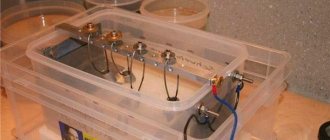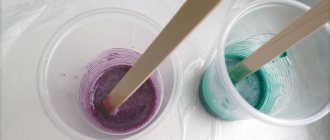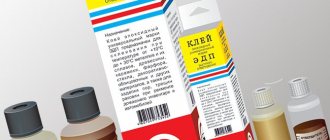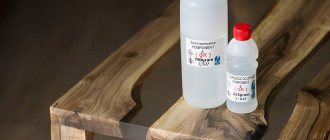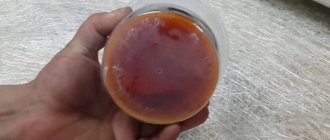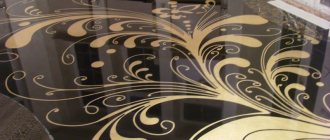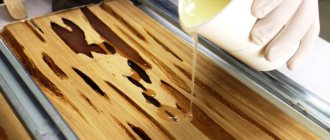Polyester resin is used for various purposes and in different fields. You can work with it at home, but in order to get a high-quality result and not cause harm to your health, you need to know certain working rules. More information about what polyester resin is, its properties and where it will be used is described below.
Compound
The composition of polyester resin is complex; each element included in it serves a specific purpose. They can be combined into several groups:
- Polyester, it contains 65-70%, is the resin base;
- Solvent content, approximately 30%, can help reduce the viscosity of the product;
- The initiator, 1.8%, starts the polymerization process;
- Accelerator, helps to increase the rate of hardening of the composition, 1.5%;
- The inhibitor inhibits the polymerization process during storage.
The composition of polyester resin is complex; each element included in it serves a specific purpose.
Technological process
The process of manufacturing unsaturated polyester resins takes place in a stainless steel or enameled reactor, equipped with a bubbler for introducing inert gas (nitrogen or CO2) with a reflux condenser and a temperature measuring device.
The condensation process of unsaturated polyesters in order to avoid their gelatinization is carried out in an atmosphere of inert gas (nitrogen or carbon dioxide) or in the presence of inhibitors: aromatic polyoxy compounds or amines. Condensation is also carried out in solvents, followed by their distillation in vacuum.
Below is the technological process for making polyester No. 1.
Castor oil, maleic and phthalic anhydride are loaded into a thoroughly washed reactor.
The reaction mixture is heated to 110–120 °C, the stirrer and nitrogen flow are turned on. Then the temperature of the mixture rises to 190 °C, and the condensation process is carried out at 130–140 °C until an acid number of 75–80 mg/KOH is achieved. Then 2/3 of the amount of ethylene glycol is introduced. The temperature of the reaction mixture is maintained within 130–140 °C, and after reaching the acid number of 40–45 mg/KOH, the remainder of ethylene glycol is added. Condensation continues at 130–140 °C until an acid number of no more than 20 mg/KOH is obtained. After this, the heating is turned off, the resin is cooled to 100–110 °C, simultaneously purged with nitrogen and unloaded. The finished resin is stored in a cold place. Guaranteed shelf life 3–4 months.
Table 2 shows the properties of polyester resins used in the electrical industry.
table 2
| Index | Resin | |||||
| № 1 | № 2 | № 315 | № 220 | EMO-1 | ESFO-1 | |
| Resin appearance | Light yellow to dark brown | Light to dark brown | Light yellow to green or brown | Transparent or slightly cloudy | ||
| Solubility in toluene 1:1 | _ | _ | _ | _ | Full | |
| Viscosity at 20 °C according to VZ-4, s | 20—40 | 20—40 | No more than 26 | 25 | 20 | 18 |
| Acid number, mg/KOH, no more | 20 | 20 | 13 | 70—83 | 30 | 30 |
| Content of hydroxyl groups, %, no more | 3,5 | 4,0 | 7 | 3,5 | _ | _ |
Note.
Polyester No. 1 (and No. 2) must be completely soluble in styrene. A solution with 1% benzoyl peroxide (by weight of the solution) should give a solid polymer at 60–100 °C for 1 hour.
Material characteristics
To better understand how to work with this material, you should understand its characteristics. These include:
- Low thermal conductivity;
- High resistance to moisture;
- Long service life of manufactured products;
- High resistance to temperature changes, ultraviolet radiation and mechanical stress;
- Withstands the influence of chemicals;
- Diverse scope of application;
- Good adhesion to different materials;
- Electrical insulation property.
High resistance to temperature changes, ultraviolet radiation and mechanical stress.
Scope of application
Polyester resin can be used in different ways. If you use it with fiberglass, you can get fiberglass with the required transparency. Polyester is widely used for the production of sanitary ware. It has also found its application in the production of paints and varnishes, adhesives, and is added to polymers necessary to create parts for radio equipment and electrical equipment.
So the resin can be used for mastics, putties, and for filling the floor. Various figurines are made from fiberglass by sculpting; this is an excellent architectural assistant. Polyester resin can provide sealing of materials. It is widely used in shipbuilding to create connections between various parts.
You can use it to repair your car bumper. Automotive parts are produced from the plastic obtained with it in its composition. The casting technique allows you to create artificial stones.
You can use it to repair your car bumper.
Physical and chemical aspects of the curing process
Polyester resins, unlike glyphthalic and pentaphthalic resins, dry faster, this happens due to their dilution with hardeners. By adding them to the components of the polyester resin, the polymerization process is started.
This paint and varnish product is characterized by good compatibility with natural and artificial types of pigments. The first variants of pigments that can be added to the material are cadmium, cobalt, chromium, and aniline dyes stand out among the artificial ones. The resin is a thick and sluggish consistency, and it is difficult to work with it in its original form; to obtain the desired consistency, it is usually diluted with styrene, which is aggressive and toxic, at least harmful to inhale.
In this case, other components are also added to styrene, these are EO octoate or cobalt naphthenate. They are responsible for accelerating the polymerization process of polyester resin, for this reason this combination is called pre-accelerated polyester resin.
At the same time, diluting the resin with pigments does not have any effect on how quickly the material dries. The process will already be started and will proceed at its own pace. In this case, after about six to ten months, the material will become very thick and it will no longer be possible to use it; this will happen at a room temperature of +18 to +24 degrees. How, after it hardens, can it be used?
This paint and varnish product is characterized by good compatibility with natural and artificial types of pigments.
Manufacturing
Polyester is obtained by refining petroleum; during this process, benzene, ethylene, and propylene are released. After exposing the material to various chemical reactions, glycols, multilayer acids, and antihydrides are obtained. All elements are combined and boiled down, resulting in a base resin.
To produce the finished product, styrene, which is toxic, is added to this composition. A similar product can be sold, but usually a number of other elements are added to it to impart additional properties: plasticizers, pigments, binding additives, etc.
After the product is manufactured, a natural polymerization stage begins, so the mixture must be used as soon as possible; the longer the material sits, the more difficult it is to work with.
To slow down the process, polyester is stored in refrigerators. Before starting work, a hardener, initiator, and catalyst are added to the composition. They must be purchased together with polyester resin.
Polyester is obtained by refining petroleum; during this process, benzene, ethylene, and propylene are released.
Polyester acrylates
Polyester acrylates are unsaturated polyester resins produced by the reaction of glycol, phthalic acid and acrylic or methacrylic acid. The reaction is represented by the diagram shown in Fig. 9.
Rice. 9.
This process is carried out in the presence of an inhibitor and a catalyst (sulfuric acid) at 90 ° C in benzene (or toluene), which is then distilled off along with the water released during the reaction. The components are loaded simultaneously. In the first stage of the process, low molecular weight esters are formed, having hydroxyl groups at the ends, which in the second stage of the process react with the carboxyls of acrylic or methacrylic acid. Due to the presence of side polymerization processes due to unsaturated groups of acrylic or methacrylic acid, free hydroxyl groups can remain, which affect the properties of the finished product. Therefore, polyester acrylates are somewhat inferior in moisture resistance to polyether maleates.
Properties and characteristics
Polyester has a yellow tint of varying degrees of saturation, the consistency is similar to liquid honey. After adding a hardener, the degree of transparency decreases and the density increases; in the middle of the polymerization process, the resin becomes similar to rubber; once it has completely hardened, the resin can be painted. Resin products are characterized by wear resistance, low thermal conductivity, high resistance to moisture, durability, resistance to chemicals, excellent adhesion and dielectric properties.
Resin products are distinguished by wear resistance, low thermal conductivity, high resistance to moisture, and durability.
Comparison with epoxy resin
What is the difference between polyester and epoxy resin, which is better to choose. The choice should be made depending on the material of the product on which they want to apply the resin and the conditions of use.
Epoxy is more expensive than polyester, but its durability is also higher. Epoxy resin is characterized by good adhesive properties, has less shrinkage, better withstands mechanical stress and is more wear-resistant.
Unlike working with polyester resin, epoxy is more difficult to work with. Due to the harmful elements contained in its composition and the composition of its hardeners.
Epoxies are often used to create countertops that can withstand mechanical stress easily.
Epoxies are often used to create countertops that can withstand mechanical stress easily.
Popular brands
On the building materials market you can find polyester resins from domestic and imported suppliers. Due to the high consumption, the material is packaged in various containers with a capacity of 1 liter and above.
- Neon S-1. Neon S-1 resin is presented by Rempolymer. It is positioned as a pre-accelerated thixotropic polyester, which is known to consumers due to its low viscosity. The main component is based on styrene, but high quality fillers are used. It is secretly believed that this brand of resin is excellent for car tuning, as well as for repairing boats and boats. The suitability time for the composition after preparation is 15 minutes. Complete curing occurs in 45 minutes.
- Reoflex Repair Resin or Reflex is known as a universal product for surface lamination. The resin belongs to the class of orthophthalic polymers and is characterized by a low styrene content. Can be used for all types of primary coating, as it has high adhesion to metals, glass, wood and paints. The Reflex polyester resin layer can withstand significant loads, temperature changes, and is also resistant to oil-containing products. The addition of a plasticizer transforms the resin into a material suitable for sealing metals. The brand is in demand by car mechanics, as it is used in the repair of plastic elements.
- Norsodyne O-12335 AL. Norsodyne O-12335 AL casting resin does not lose its optical properties when exposed to light. Its resistance to ultraviolet radiation is widely used in finishing works. The pre-accelerated resin takes on a gelatinous consistency within 20 minutes. A special hardener is produced for it - Butanox. The share of hardener is 0.3-2% of the volume of the base composition. Norsodyne resin exhibits adhesive properties even at a temperature of 15°C degrees, while the lower limit for other models is 20-22°C degrees.
- Novol Plus 720. High-quality material with average performance - Novol Plus 720 resin. It is used as glue when working with rubber products, as a binding component for plastic, and also as a sealant, and holes can be sealed in metal, glass, plastic and wood. The strength of polyester allows it to be used to strengthen boat hulls, and resin is used as an additive even when repairing car bodies.
Good to know > French epoxy resin Pebeo Gedeo
Butanox hardener is added to component “A” (basic composition). Its exact quantity is determined by the manufacturer. The average hardener share is 2.5%. Cured polyester is processable. It can be sanded and coated with varnish or paint.
Application
In addition to the areas of application of polyester resin listed above, we can highlight its use in everyday life, as an impregnation for porous substances, or as a sealant or primer. It is used in body repair, and primers and putty solutions for cars contain this material.
It is used to cast window sills, cornices, roofs, and can also produce shades for lighting items. As you can see, the application of the composition is very diverse, and polyester can be used both in industry and in everyday life.
It is used in body repair, and primers and putty solutions for cars contain this material.
Features of unsaturated polyester resins
Unsaturated resins are used more often, because for the rapid curing process it is not necessary to resort to high temperatures; the process occurs at temperatures of +23 degrees. Also, the advantages of this type include less danger to the health of the person working with it. The scope of application of unsaturated resins is also wide.
The advantage of this type is that there is less danger to the health of the person working with it.
Room temperature
Professionals advise working with this material at a room temperature of at least 23 degrees above zero. There are resins on the market, this usually applies to paints and varnishes, work with which can also take place in microclimates of +15 degrees. This information can be found on the product packaging.
In theory, curing of these types will take a long time, about a month. Therefore, in order to improve sales, the manufacturer prepares elements for polyesters of this type for acceleration and polymerization so that diluting them, even at such temperatures, starts the self-heating process, and the process is carried out within an acceptable time frame. They can be varied by changing the accelerator ratio. It is important to follow the instructions here.
How to dilute polyester resin with a hardener, the procedure for introducing all necessary additives includes:
- It is necessary to accurately measure the amount of resin and accelerator (if it was not added earlier before sale), you can find out by studying the packaging, these details must be written on it.
- You should not mix them together or move vigorously, so as not to cause the formation of excess air bubbles; mixing time should be spent 3-5 minutes.
- Add a curing initiator, mixing should last three minutes, if the climatic conditions of the room are hotter than standard, then it will take less time.
- They proceed to pouring the composition into molds or pouring it over the surface; it is important to do this 10-12 minutes before moving on to the gelatinization stage.
- To speed up the transition to the next stage, the temperature in the room must be increased, and, conversely, to slow it down, it must be decreased.
- Primary hardening will occur after 14 hours - a day.
Primary hardening will occur after 14 hours - a day.
Solvents, accelerators and inhibitors
It is mandatory to add a solvent to the composition; it serves to reduce the density of the product, as well as to slow down the polymerization process so that the polyester substance does not harden too quickly. To effect the transition to a solid state, catalysts are used, and hydroperoxide can serve as a separator. The accelerator can be added immediately or for stabilization during operation; cobalt salt is usually used as it. If these elements are not added, the curing process will proceed at a slow pace, or vice versa, too quickly.
It is mandatory to add a solvent to the composition; it serves to reduce the density of the product, as well as to slow down the polymerization process.
Working with polyester resin
The work begins with studying the instructions on the product packaging; adding components occurs strictly according to the specified ratio and quantity. For beginners, the best way is to prepare the solution in small portions. The accelerator must be poured in gradually, while stirring carefully so that bubbles do not form in the mixture. During the process, the temperature of the mixture will begin to rise, this is the polymerization process, coloring the resin blue means strong heating.
If there is a need to slow down the process, you can immerse the container with the liquid in cold water.
When the liquid reaches the gelatinization stage (20-60 minutes), it cannot be changed; shaping and adjustments afterward are no longer desirable, otherwise the properties will be lost. Hardening occurs after 2-24 hours, complete hardening occurs after 7-14 days.
For beginners, the best way is to prepare the solution in small portions.
Technology of covering SUP Board with fiberglass
The choice of gluing direction is to place along the length of the SUP those fabric threads (weft or warp) that have greater total strength.
Cut the fiberglass panels into pieces. Do this in advance, when the risk of staining the fabric with resin is minimal. Dry try the pieces on the body. The overlap of the pieces should be 5-10 cm.
Prepare a velor roller and plastic spatulas (7-8 cm wide).
If you use ball foam (it is cheaper than extruded foam), then you need to prime the foam with PVA glue. Sand all the places where the homemade SUP Board is covered; the epoxy resin does not adhere well to the smooth and unsanded foam and can bounce off during use.
Mix the resin, try to work with components at room temperature.
Begin to apply the resin to the plywood with a roller, thoroughly wetting the surface. Apply resin to the entire area that will cover the first piece of fiberglass. Add resin where it is completely or heavily absorbed.
After applying the resin, lay the fabric on the wetted surface. The fabric will begin to become saturated with resin in places and stick to the surface. Smooth the fabric onto the surface, but don't try to do it in the same way as you would smooth the fabric lying on the table. You need to pull only the edges of the fabric, choosing those threads that pass through the areas that require alignment. This way you will avoid the formation of folds in the fabric. The structure of the fabric is disrupted by folds, their appearance should be avoided.
Once the fabric is generally leveled, begin applying resin over the fabric. You can do this with a roller; you can also use a plastic spatula, which effectively distributes the resin throughout the fabric. Help with a roller on uneven areas. Act quickly, without forceful pressure.
After soaking the entire cloth, check the surface again and remove any bubbles by removing air from under the cloth with a spatula. At this stage, you need to remove the edge synthetic thread from the edge of the fabric. It keeps the edge of the fabric from fraying and is no longer needed. If the thread is left, it forms an unnecessary roll, especially if it overlaps with another fiberglass panel.
Always check the previous one for bubbles and peeling that may occur while you are working with the new one.
The final operation is to fill the fabric structure with resin where the resin is more deeply absorbed into the base and distribute the excess resin. The best tool for this is a plastic spatula. The pressure on the surface should be moderate to avoid displacing the fabric.
How to properly impregnate fiberglass with epoxy resin
Polyester resins and glass mats
Glass mats are fiberglass units that are made up to five centimeters in size. They are combined together to obtain a material similar to fiberglass. Their density indicators are lower, but they are easier to work with. By adding polyester resin to glass mats, a pliable material is obtained that can be shaped and bent into the desired shape.
By adding polyester resin to glass mats, a pliable material is obtained that can be shaped and bent into the desired shape.
Other types of resins
There are other types of materials that can replace those described above. They are less popular, but still used in industry.
Vinylester resins
These are modern types of materials, the principle of formation of which is similar to that of polyester. Vinyl ester resins are more durable - this property is given to them by the epoxy molecules included in their composition. Shrinkage is higher than that of epoxy, but lower than that of polyester.
Other material characteristics:
- does not allow microcracks to form,
- increases adhesion to surfaces,
- has high water-resistant properties.
Unfortunately, such materials contain harmful substances (styrenes), although a number of modern modifications do not include these elements. The downside is poor polymerization at normal temperatures. The price of the products is high, slightly lower than the cost of epoxy resins.
During operation, care must be taken: when applied to dissimilar surfaces, there is a risk of detachment of the outer part of the coating. The material shows the best adhesion to fiberglass, while its adhesion to carbon fiber and Kevlar is worse.
Bakelite resin
Bakelite is a product of polycondensation of phenol with formaldehyde with the participation of an alkaline catalyst. The material belongs to thermosets and is formed at the initial stage of production of phenol-formaldehyde resin. In appearance, bakelite resin is a viscous liquid of light yellow, dark yellow color.
The material is used as a connecting link in the production of abrasive products of hot, cold pressing and rolling. The property of bakelite to transform into an insoluble form when heated for a long time is used for the preparation of plastics. Alcohol solutions are used as varnishes.
Material properties:
- high resistance to friction, pressure, shock,
- poor thermal conductivity,
- easy processing on machines,
- electrical insulating qualities,
- no damage from alkalis and cold acids,
- resistance to temperatures up to +300 degrees.
Epoxy vinyl ester resins
Such materials are characterized by the highest chemical resistance and can protect products from corrosion. They are especially popular in production, where the anti-corrosion properties of fiberglass are needed.
Thanks to these qualities, epoxy vinyl ester resins can be used in a number of industries:
- chemical,
- cellulose,
- semiconductor,
- energy,
- metalworking,
- petrochemical production,
- release of medicines,
- recycling.
The application of chemical-resistant resins makes the products protected from solvents, oxidizing agents, chlorides, and alkalis. Some types of epoxy vinyl ester resins can withstand temperatures up to +315 degrees, but most of them can be used for a long time up to +175 degrees. The service life of fiberglass is several decades. The cost of the material is moderate - lower than that of epoxy resins.
Isophthalic resin
This type of material belongs to polyesters, the only difference is in the specifics of the production process. Isophthalic resin differs from standard polyester molecular weight and structure. This determines slightly different properties of the finished fiberglass.
Isophthalic materials have a complex structure. Their other properties:
- high impact strength,
- excellent adhesion to glass fibers,
- ability to withstand large static and dynamic loads,
- low water absorption,
- can be applied manually and by spraying.
Orthophthalic resins
Compared to isophthalic resins, orthophthalic resins have a less complex structure. The composition contains special additives that improve environmental performance and reduce the harmfulness of fumes. Some do not contain styrene at all and are considered safe.
A number of resins contain paraffin and are intended to create a surface film on the laminate. Orthophthalic resins harden quickly and need to be worked with within a short period of time.
Impact on human health
The content of toxic elements in the product requires compliance with safety measures during operation. The technician must wear safety glasses and a respirator. Good ventilation must be provided in the room, there should be no sources of open fire nearby; if a fire occurs, extinguishing with water is unacceptable; sand or a fire extinguisher must be used. If contact with the skin cannot be avoided, the area is washed with soapy water; it is recommended to have a special product for cleaning polyesters available.
The content of toxic elements in the product requires compliance with safety measures during operation.
Polyester resin has a number of positive properties, with which you can do a lot of work. The main thing is to pay attention to safety rules and mix strictly according to the instructions described by the manufacturer.

